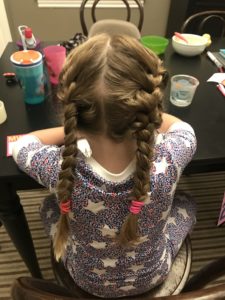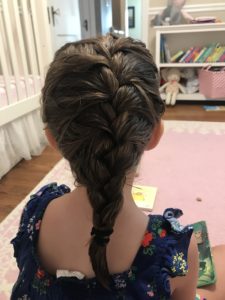Head Lice

Back to school comes with lots of fun things – a new backpack and lunch box, seeing old friends and making new ones, the start of Fall. Unfortunately, it also causes an increase in the amount of lice we see in our office. While harmless, these bugs are irritating for the whole family and can lead to absences from school and work. This school year, be armed with the knowledge of how to prevent and, if needed, treat these pesky uninvited guests.
What are lice?
Lice are tiny gray bugs that can infest the scalp. They are about the size of a sesame seed and move quickly so can be difficult to see. What you often do find are their white eggs, called nits, which firmly attached to hair shafts near the skin. Unlike dandruff or sand, nits cannot easily be shaken off the hair shaft. Most people who get lice complain of an itchy scalp. Lice do not carry diseases and will not make you feel sick.
Lice life cycle
Nits hatch into lice in about one week. They can survive off the scalp during that time which makes cleaning your house imperative when treating a lice infection in the family. Adult lice can live three weeks on the scalp and feed every few hours on tiny amounts of blood from the scalp. Off the scalp, adult lice cannot survive for more than one day without a blood meal.
Transmission
Nits cannot pass from person to person; only live lice can infect other people. Almost all transmission is from direct head-to-head contact. Since lice cannot jump or fly, it takes about 30 minutes of direct contact for a louse to crawl from one head to another. However, indirect transmission from hats, hairbrushes, headphones and other objects is possible though less common. Most transmission of lice happens at home, through sleepovers and bed sharing.
 Treatment
Treatment
Anti-lice shampoo (such as Nix which is over the counter) is the mainstay of treatment and requires two treatments so be sure to follow the package directions. Prescription anti-lice medication such as Sklice, is also available and requires only one application. Discuss with your doctor if this is a good choice for your family.
When using the anti-lice shampoo, first wash hair with a regular shampoo and towel dry. Do not use conditioner on the hair as it interferes with the lice treatment. Pour 2 ounces (one box of Nix if that’s what you are using) into damp hair. People with long hair may need to use two boxes. Work the cream into all the hair down to the roots and add a little warm water if needed to work up a lather. Leave the shampoo on for a full 10 minutes and then rinse the hair thoroughly with water and towel dry. Again, do not use conditioner. Do not shampoo the hair for 48 hours after application of anti-lice shampoo and avoid hair conditioner before treatment as well as for 2 weeks after.
Most importantly, most over the counter shampoos require that you repeat the entire process 9 days later to kill any nits that survived. Since nits hatch 6-9 days after being laid, the second treatment will ensure that lice that hatch from surviving nits are also killed.
Preventing Spread
Now that the hair is under control, it’s time to address the house. Vacuum your child’s room thoroughly as well as the rest of the house. Soak hairbrushes for 1 hour in a solution containing anti-lice shampoo. Wash bed sheets, blankets, pillowcases and any clothes worn in the past three days in hot water; water temperature of 130 degrees Fahrenheit kills lice and nits. For items that cannot be easily washed, such as hats or stuffed animals, place them in sealed plastic bags for 2 weeks to ensure that all nits and lice are dead. Remind family members not to share combs or hairbrushes to prevent passing lice in the future.
Most importantly
Don’t stress! Lice infection does not happen because of a lack of cleanliness – it just happens. If you follow the above steps, lice and their nits should be successfully killed. Children can return to school and daycare after treatment with an anti-lice shampoo. A child does not need to miss any school or childcare due to nits remaining after treatment since nits are not contagious. Always contact your doctor if you are unsure if your family has lice, are unable to successfully treat them with the above steps, or have additional questions.
Wishing you a happy and lice free school year!


